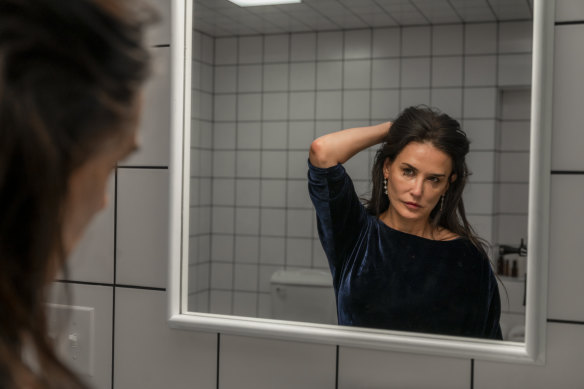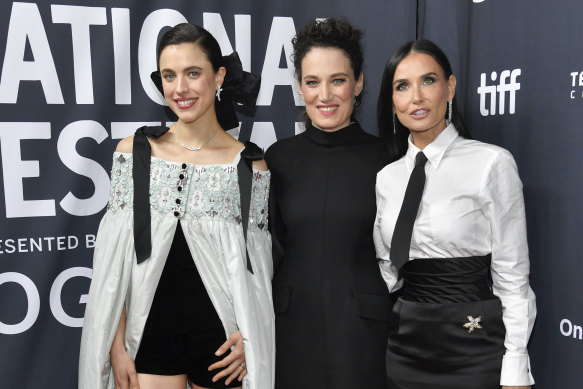This was published 10 months ago
Demi Moore on the male gaze, the beauty myth, and the horrors of latex
The Substance stars Demi Moore and Margaret Qualley share their thoughts on the body horror film, and why they don’t necessarily agree with its director.
By Karl Quinn

Demi Moore as Elisabeth Sparkle, a TV exercise show presenter deemed past it by her station boss (Dennis Quaid), in The Substance.Credit: Madman
Demi Moore and Margaret Qualley are sitting side by side as we chat over Zoom, which is appropriate, as they play the same woman in the hilariously shocking body horror film The Substance. Well, sort of. Moore, who is 61, and Qualley, 29, actually play two versions of this woman, both of whom exist, thanks to the movie’s bizarre central conceit, in more or less the same place and time.
Elisabeth Sparkle (Moore) is a former actor and host of a Jane Fonda-style TV exercise program who, at the age of 50, is deemed too old by her sleazy station boss (Dennis Quaid). But when she comes across a mysterious cosmetic treatment known as The Substance, she is suddenly able to generate a younger version of herself called Sue (Qualley), and thus extend “her” time in the spotlight.
The promise is compelling: one consciousness, two bodies. The catch: they must switch back every seven days, or else. The dilemma: Sue is having such a good time she just doesn’t want to hand over the reins. The result: sheer bloody mayhem.
“It’s utterly singular,” says Qualley of Coralie Fargeat’s film, which is set in Hollywood, was shot in France, and is now showing in Australia. “It kind of reads as this f---ed up inverted fairytale on the world.”

From left: Margaret Qualley, Coralie Fargeat and Demi Moore at a screening of The Substance at the Toronto International Film Festival this month.Credit: AP
“I had some caution,” admits Moore of her initial response to the script. “It felt like this could either be something amazing or an absolute disaster. But I was intrigued enough that I ultimately really wanted to do it.”
Make no mistake, The Substance is fuelled by rage. As she explains in her director’s statement for the film, Fargeat is taking aim at the beauty myth and the male gaze, and she’s squeezing the trigger hard.
“Everything around us, in commercials, movies and magazines, showcases fantasised versions of ourselves,” she says. “Always beautiful and thin and young and sexy. The version of the ‘ideal woman’ that is supposed to bring us love, success, happiness.
“And if we step out of those boxes – whether it is with age, weight, curves – society tells us, ‘You’re done, we don’t want to see you any more. We don’t want you on our screens. We don’t want you on the covers of our magazines. We will just erase you from the public space. You’re not worth society’s time and attention’.”
Fargeat wrote her movie, she says, “to make a political statement to the world: we should be done with this shit”.
So do Moore and Qualley share the director’s anger about all this?
“I do not,” says Moore unequivocally.
“No, I do not,” says Qualley.
“I mean, I really understand it, I really have compassion,” Moore qualifies. “And I know culturally the level of judgment and repression that women have experienced. I just choose not to buy into that as my reality. And I feel like I don’t hold men as the object of my discontent.”
Moore certainly knows what it’s like to ride the Hollywood rollercoaster. She broke through as a 20-year-old on TV soap General Hospital, had by the mid-1980s been shoehorned into the so-called Brat Pack, and became, after a string of smash hits in the early 1990s – Ghost, A Few Good Men and Indecent Proposal chief among them – one of the industry’s most bankable stars.
In 1996 she was paid $US12.5 million for Striptease, a movie that could well serve as a definitive illustration of “the male gaze”. It was the most any actress had been paid to that point, but the film was panned so mercilessly by critics – many of whom singled out Moore’s performance for special vitriol – that it marked both the high and low point of her career.
Does any of that make her feel particularly able to relate to Elisabeth’s experience in The Substance as a woman once feted for her beauty but now feeling somewhat cast aside?
“I think we all have certain personal experiences as we age, there’s certain things that we are aware of,” she says. “It’s what we choose to make that mean about us. I feel like I’m very different from Elisabeth. While I have awareness and can really understand and identify with what she’s experiencing, it’s …”
“Well,” Qualley jumps in, “Elisabeth never would have played this part. Demi is starring in one of the most cutting-edge stories and baring every single bit of herself. And she’s writing the rules for her own game.”
Both women appear naked in the film. They also appear covered in massive amounts of prosthetics as the negative consequences of the devil’s bargain Elisabeth has made with the shady purveyors of The Substance assert themselves. Which was harder – the nudity or the latex?
“The tonnes and tonnes of latex, absolutely,” says Qualley, who is the daughter of Four Weddings and a Funeral star Andie MacDowell and an actor very much on the rise.
“I think the prosthetics,” agrees Moore. “The nudity was really more about the vulnerability that needed to be illustrated. In terms of the process, eight hours of prosthetics is no walk in the park for anybody – not on your skin, not on your psyche, not on your emotional stability.”
“I think body horror might feel like body horror when you’re making it,” adds Qualley.
The only time the two women share the screen is in those brief moments of crossover, at the end of the seven-day cycle. But the logistics of making the movie meant they were on set together much of the time.

Margaret Qualley describes The Substance as “utterly singular”.Credit: Madman
“There was so much intense prep to go into every single shot, so she’d be prepping, I’d be shooting, I’d be prepping, she’d be shooting,” says Qualley. “We’d be just tapping in and tapping out.”
“I think we were really grounded in looking out for each other and just being there for each other in what was obviously a very shared experience,” says Moore. “Not to mention when our bodies had to be lying on top of each other on a cold tile floor for hours. ‘Move your leg a little bit that way; cover it that way’.”
If the actors were putting their bodies at the service of Fargeat’s vision, their minds remained – and remain – very much their own. Their director’s unflinching take on the male gaze is legitimate and clearly heartfelt, but each of them has their own way of making sense of it that perhaps sits slightly at odds with Fargeat’s own.
“While the circumstance is all about the male gaze, for me it was much more about the perception of the male gaze that was trying to be met,” says Moore. “It’s what she was doing to herself based on that, not what was being done to her.”
“Yeah, yeah,” agrees Qualley. “It’s very much Coralie’s interpretation of the male gaze, so when I would feel lost, she would kind of be my compass, in the sense that when I felt miles away from Sue, or miles away from what [Fargeat] needed Sue to experience, I would imagine what she experienced.”
In Moore’s mind, if Elisabeth/Sue is a victim, she is not one without a certain degree of culpability, because given the chance to reset she merely hits repeat.
“When Sue emerges, there’s this opportunity, she’s got everything available to her,” says Moore. “But isn’t it interesting that she still seeks the same approval, she’s repeating the same pattern?
“It would have been a different movie, but Sue could have said, ‘You know what, I want to produce my own show, I’m going to be in charge’. But she doesn’t. She still goes after the same acknowledgement, the same validation, getting the same job.
“That is very true to us as humans,” she says, “not just for women.”
The Substance is in cinemas.
Find out the next TV, streaming series and movies to add to your must-sees. Get The Watchlist delivered every Thursday.